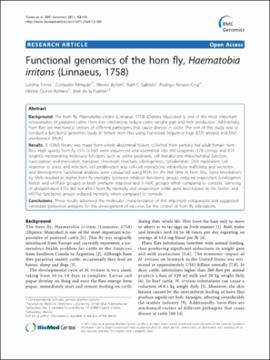| dc.contributor.author | Torres, Lorena | |
| dc.contributor.author | Almazan, Consuelo | |
| dc.contributor.author | Ayllon, Nieves | |
| dc.contributor.author | Galindo, Ruth C. | |
| dc.contributor.author | Rosario-Cruz, Rodrigo | |
| dc.contributor.author | Quiroz-Romero, Hector | |
| dc.contributor.author | de la Fuente, Jose | |
| dc.date.accessioned | 2018-11-09T21:10:58Z | |
| dc.date.available | 2018-11-09T21:10:58Z | |
| dc.date.issued | 2011-02-10 | |
| dc.identifier | oksd_torres_functionalgeno_2011-02-10 | |
| dc.identifier.citation | Torres, L., Almazan, C., Ayllon, N., Galindo, R. C., Rosario-Cruz, R., Quiroz-Romero, H., & de la Fuente, J. (2011). Functional genomics of the horn fly, Haematobia irritans (Linnaeus, 1758). BMC Genomics, 12, Article 105. https://doi.org/10.1186/1471-2164-12-105 | |
| dc.identifier.uri | https://hdl.handle.net/11244/302077 | |
| dc.description.abstract | Background: The horn fly, Haematobia irritans (Linnaeus, 1758) (Diptera: Muscidae) is one of the most important ectoparasites of pastured cattle. Horn flies infestations reduce cattle weight gain and milk production. Additionally, horn flies are mechanical vectors of different pathogens that cause disease in cattle. The aim of this study was to conduct a functional genomics study in female horn flies using Expressed Sequence Tags (EST) analysis and RNA interference (RNAi). | |
| dc.description.abstract | Results: A cDNA library was made from whole abdominal tissues collected from partially fed adult female horn flies. High quality horn fly ESTs (2,160) were sequenced and assembled into 992 unigenes (178 contigs and 814 singlets) representing molecular functions such as serine proteases, cell metabolism, mitochondrial function, transcription and translation, transport, chromatin structure, vitellogenesis, cytoskeleton, DNA replication, cell response to stress and infection, cell proliferation and cell-cell interactions, intracellular trafficking and secretion, and development. Functional analyses were conducted using RNAi for the first time in horn flies. Gene knockdown by RNAi resulted in higher horn fly mortality (protease inhibitor functional group), reduced oviposition (vitellogenin, ferritin and vATPase groups) or both (immune response and 5'-NUC groups) when compared to controls. Silencing of ubiquitination ESTs did not affect horn fly mortality and ovisposition while gene knockdown in the ferritin and vATPse functional groups reduced mortality when compared to controls. | |
| dc.description.abstract | Conclusions: These results advanced the molecular characterization of this important ectoparasite and suggested candidate protective antigens for the development of vaccines for the control of horn fly infestations. | |
| dc.format | application/pdf | |
| dc.language | en_US | |
| dc.publisher | BioMed Central | |
| dc.rights | This material has been previously published. In the Oklahoma State University Library's institutional repository this version is made available through the open access principles and the terms of agreement/consent between the author(s) and the publisher. The permission policy on the use, reproduction or distribution of the material falls under fair use for educational, scholarship, and research purposes. Contact Digital Resources and Discovery Services at lib-dls@okstate.edu or 405-744-9161 for further information. | |
| dc.title | Functional genomics of the horn fly, Haematobia irritans (Linnaeus, 1758) | |
| osu.filename | oksd_torres_functionalgeno_2011-02-10.pdf | |
| dc.description.peerreview | Peer reviewed | |
| dc.identifier.doi | 10.1186/1471-2164-12-105 | |
| dc.description.department | Veterinary Pathobiology | |
| dc.type.genre | Article | |
| dc.type.material | Text | |
| dc.subject.keywords | serine protease | |
| dc.subject.keywords | tick infestation | |
| dc.subject.keywords | tick cell | |
| dc.subject.keywords | protease inhibitor gene | |
| dc.subject.keywords | gene expression silence | |
